“We may profess to know the heart, but its essence is beyond our reach.” ~Ansem The Wise
When I first heard this quote while playing through Kingdom Hearts II, a gigantic smile came to my face. The quote drives home the main reason why I love the Kingdom Hearts series: Its focus on the mysteries of the heart, and how logic and science will always fail at understanding the true nature of these more spiritual things.
Instead, Kingdom Hearts is a Romantic series at its core. It argues that the heart is in essence an unpredictable immaterial object, that can only be approached and appreciated through the bonds and friendships we form with each other. I’ll spend this article detailing several different ways the Kingdom Hearts series has explored this topic over the past eighteen years. I will also explain how Kingdom Hearts’ themes spring from the philosophical movement of Romanticism:
The Paopu Fruit:
This theme about the importance of bonds is introduced almost immediately in Kingdom Hearts 1 through the symbolism of the paopu fruit and the connection that it brings to Sora and Kairi. After the first cutscene on Destiny Islands, Riku tosses Sora a star-shaped fruit:
Sora: A Paopu fruit…
Riku: If two people share one, their destinies become intertwined. They’ll remain a part of each other’s lives no matter what. C’mon, I know you want to try it.
Sora: What are you talking-
Sora has a crush on Kairi, and this is confirmed when Sora crawls into the “secret spot” near the waterfall. He uses a piece of rock to etch a drawing of him giving the fruit to Kairi into the wall side. Later on, during the end credits of the game, Kairi draws a similar picture with her handing him one as well.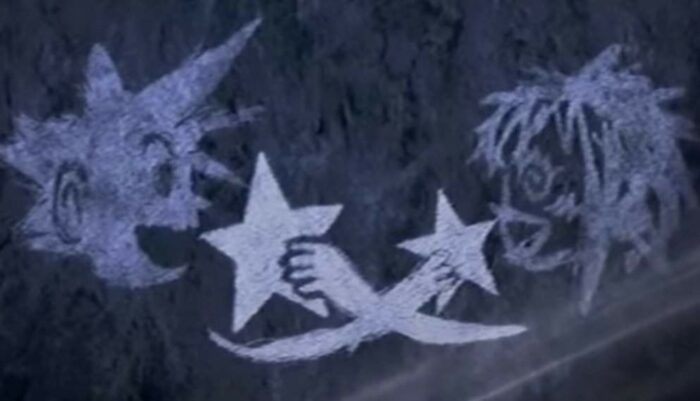
The symbol of the paopu fruit shows up in the game series’ later artwork as well, but It’s not until the recent Kingdom Hearts III that this event actually comes to pass. Before the climactic battle against Master Xehanort, Sora and Kairi sit on a branch on the island and share the idyllic moment together:
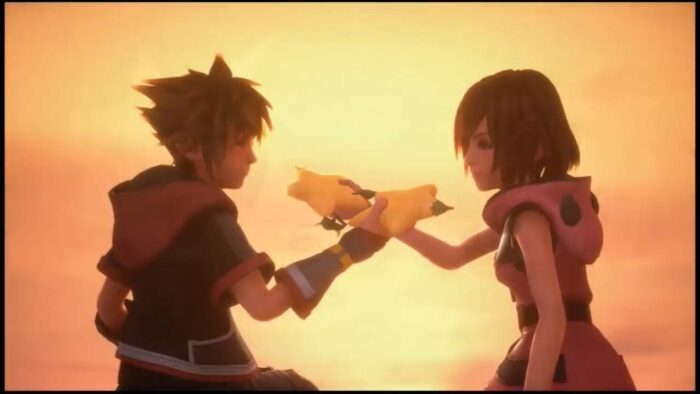
The bond between Sora and Kairi is solidified with this sharing of the paopu, and future moments go to great lengths to make this clear. In Melody of Memory, Kairi fights an imprint of Xehanort inside of her own memories. At first, she holds her own, but eventually, she is overpowered. Xehanort is about to deal the finishing blow when Sora takes possession of Kairi and transplants his own consciousness into her. This is an impressive feat, considering that Sora is worlds away, perhaps even in a different “fictional” world altogether. Though for all Sora’s power…
Who’s Inside of Sora:
In all honesty, he just isn’t that interesting of a character. He’s a shonen-anime archetype right down to the spiky hair and his optimistic attitude. Indeed, whenever Sora gets waylaid by his enemies, he always manages to get back up again with a smile on his face. He says time and time again that his friends are his power: Donald, Goofy, Kairi, Riku, Mickey, and Yensid, etc. But he spends much of the series not knowing of the friends that are inside of him.
At the beginning of Birth By Sleep, Master Xehanort attempts to use Ventus to construct the x-blade, but Ventus’ reluctance to tap into his own darkness frustrates Xehanort, who instead decides to extract the darkness from Ventus. This results in the creation of Vanitas but leaves Ventus with a damaged heart. When Xehanort brings Ventus to Destiny Islands, Sora’s heart connects with Ventus’ heart and keeps it from collapsing in on itself. Finally, when Ventus loses his heart in his battle against Vanitas, his heart once again turns to Sora, where it then takes residence.
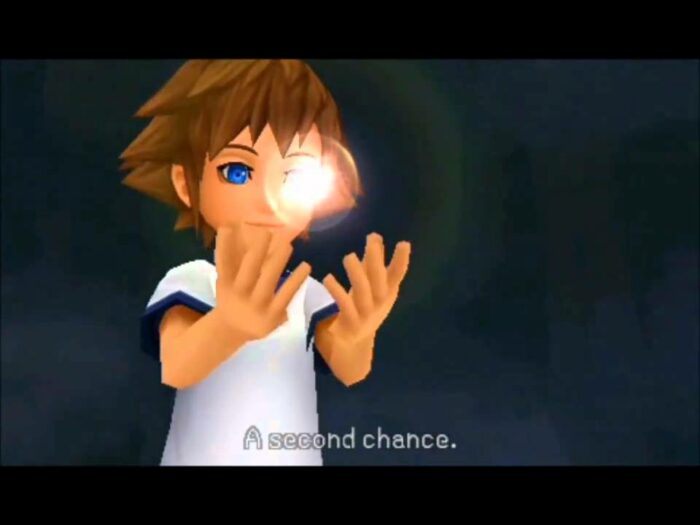
In fact, Sora serves as the home of not just Ventus throughout the Kingdom Hearts storyline, but also Xion and Roxas. Both of these characters are special, in that they are nobodies, who according to early game mythology, don’t have hearts. But that changes later on…
Nobodies Can Grow Their Own Hearts (As can Replicas and Data Clusters)
Early in Kingdom Hearts II, Yen sid warns Sora not to trust nobodies:
An empty vessel whose heart has been stolen away… A spirit that goes on even as its body fades from existence—for you see, Nobodies do not truly exist at all. Nobodies may seem to have feelings, but this is a ruse—they only pretend to have hearts. You must not be deceived.
Sora takes this advice at face value. It is not until Dream Drop Distance when a resurrected Xemnas tells Sora that nobodies can, in fact, grow hearts through building relationships with other people, that he discovers the truth. But more observant gamers, if they had been paying attention, would have noticed that this theme of so-called “fake” characters gaining their own agency has been a part of the series’ mythology since as early as Chain of Memories.
Riku Replica from CoM is just such a character. Crafted from Vexen’s collected data on the actual Riku, the replica has his memories overwritten to make him believe he’s the real Riku. He fights Sora on multiple occasions, and towards the end of the game, he saves Namine from Marluxia. Eventually, the replica discovers his true nature. Although he is disheartened that he is a “fake” he is still recognized by Sora as a unique individual who is worthy of being treated with compassion:
Riku Replica: Not Riku. I’m a fake. I can’t remember why I was created or where or when… All that’s inside of me—is time with you and Naminé. But I know those memories are not real.
Sora: Wait! Who cares if someone created you? You are you and nobody else. You have your own heart inside you. Those feelings and memories are yours and yours alone. They’re special!
The real Riku also shows the replica kindness. After his defeat in front of the mysterious mansion in Twilight Town, the replica fades back into nothingness. Before his final moments, the replica seeks reassurance from Riku about where his heart will go. Riku comforts the replica, telling him that his heart will end up in the same place his will.
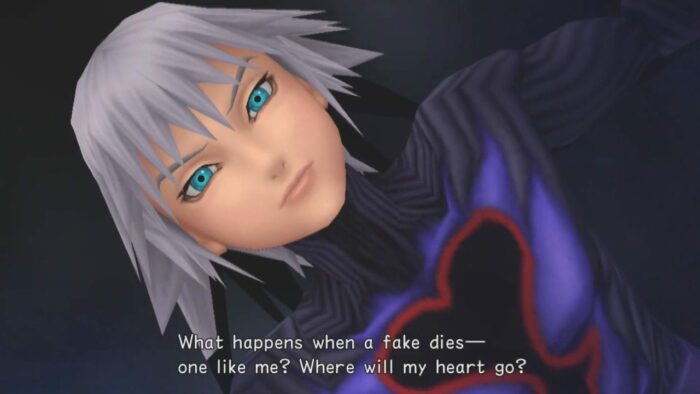
Data-Sora is another character who, despite being a copy of the actual Sora, gains his own sense of self through the bonds he forms. In Re: Coded, as Data-Sora erases the bugs that have formed in different worlds, he also builds relationships with Donald, Goofy, Mickey, and the journal itself (in the guise of Riku).
Unfortunately, when he finally defeats the heartless that is corrupting the journal, his data is reset, and he forgets all the friendships that he made. But his heart retains the feelings that are linked to those friendships. When tasked with making his way through a data version of Castle Oblivion, it is those feelings that he comes to rely upon. As Mickey tells Data-Sora :
Memories can dissapear, but feelings don’t. . .not even when your data was reset. Inside your heart, the adventures you shared with your friends you made in the datascape will always live on.
The implication here is that the body is more than just a physical instrument. It goes beyond data and science. It has its own spiritual dimension that retains feelings that are linked to memories, even when those memories are no longer present. The real-world counterpart here would be the soul or the more metaphysical part of ourselves. And this cannot be replicated through science alone.
Doctor Finklestein’s Attempt: The Missing Ingredient
In the original Kingdom Hearts, Dr. Finklestein, from The Nightmare Before Christmas, attempts to recreate a heart in his lab. At first, he uses two ingredients to make the heart: pulse and emotion. Unfortunately, the experiment malfunctions. He sends Sora out to collect two more ingredients: memory and surprise. However, even with these additional items, the heart still fails to function properly.
Finkelstein questions what could possibly be missing from his experiment, since his projects almost always succeed. The plotline for the world ends at this point, but the implied reason is that a heart cannot be created artificially. It’s missing the key ingredient of humanity, and humanity is gained, once again, through forming relationships.
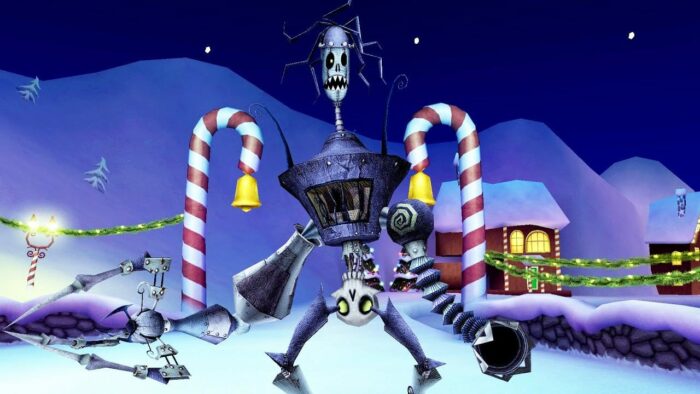
Kingdom Hearts II brings up this topic once more. Dr. Finklestein creates an artificial experiment that goes on a rampage stealing presents. Sora, Finkelstein, and Sally ponder over the monster’s intentions after they defeat the creature. They conclude that since it had no heart, it was attempting to gain one through collecting presents. Why presents? Well, Sally has this to say to Sora:
Sora: But if it wanted a heart, why was it going around stealing all those Christmas presents?
Sally: Maybe because…presents are a way to give your heart to someone special.
Sally goes on to convey that what really counts and what is “really special” is the act of giving the gift. “To wish deep in your heart to make someone else happy.”
Clearly, technology and science can only get so far when attempting to understand matters of the heart.
Ansem The Wise
Ansem the Wise realizes this fact when he attempts to reclaim Kingdom Hearts and encode it as data near the end of Kingdom Hearts II. The machine malfunctions, explodes, and takes him to the Realm of Darkness. Before he passes, however, he realizes his mistake and communicates his thoughts to Mickey:
The process of encoding hearts is incalculable. The inhabitants of my Twilight Town were data created from real hearts. I was convinced that they would think and behave the way I had envisioned—but I couldn’t have been more wrong. A heart is so much more than any system. I saw it when Roxas and Kairi crossed paths. I knew. But I was too stubborn to accept it. It’s always the same. I try to wrap my mind around things my heart already knows, only to fail. While I was trying to bring Sora back, I had so many plans in store. But once Sora was an acting force, they fell apart. All my research amounted to nothing, compared with that one boy’s heart.
Ansem’s research on the heart, which is a large part of what set the whole plot of Kingdom Hearts into motion, is insignificant when compared to the actual thing itself. Even with his intellectual prowess, he was unable to grasp an understanding of the heart. Or even how his own artificial creation would work in his own data constructed town. In the end, his experiments surprised him, and his expectations were upended.
Romanticism
These themes of the unpredictability and power of the spirit over the human intellect echo the themes of eighteenth-century Romanticism. The Romantics preferred intuition and matters of subjective emotional experience over rationalism and system making. They felt that any attempt to reach an objective truth could not easily describe the nature of each human individual. Instead, they sought to capture truth through the experience of the heart.
Romantics too would see the faults of attempting to create a heart from scratch or a monster without one (think Mary Shelley’s Frankenstein). They would value the rebelliousness and unpredictability of all of the “fake” characters of Kingdom Hearts and would champion their seeking of an authentic human experience. Most importantly, they would honor the bonds that Sora, Riku, Kairi, and others form with the rest of the Kingdom Hearts cast.
Both Kingdom Hearts and the Romantics argue that it is our emotional experiences and our own inner feelings that bring value to our experience as human beings. And those experiences are extremely unpredictable and spiritual in their own right. They are unique for each individual and any attempt to grasp the essence of them through only the human intellect will fail.

